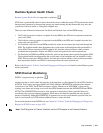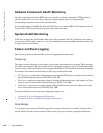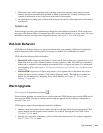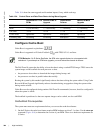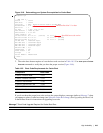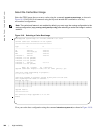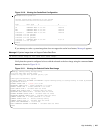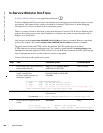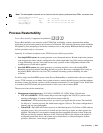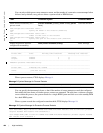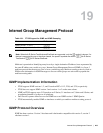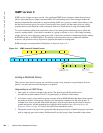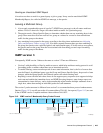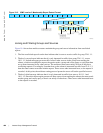
High Availability | 399
Process Restartability
Process Restartability is supported on platforms: c e s
Process Restartability is an extension to the FTOS High Availability system component that enables
application processes and system protocol tasks to be restarted. This extension increases system reliability
and uptime by first attempting to restart the crashed process on the primary RPM and then executing the
failover procedure only as a last resort.
Currently, if a software exception occurs, FTOS executes a failover procedure:
• In a single-RPM system, the system generates a core dump and reboots. Reloads require the system to
read and apply the entire startup-configuration file, which might take long if the startup-configuration
is large. Restarting a process saves time because only a portion of the configuration related to the
crashed process is read and re-applied.
• In a dual-RPM system, the system generates a core dump and fails over to the standby RPM.
Restarting a process precludes launching the failover process. Recovery is attempted first locally on
the primary RPM, which involves less CPU overhead, increasing system availability for other
activities.
For both a single and dual-RPM system, when Process Restartability is enabled and a software exception
occurs, FTOS: executes a core dump, frees system resources, restarts the failed process, and then updates
the restart counter. By default, a process can be restarted a maximum of 3 times within 1 hour. If this limit
is exceeded, the FTOS reloads the system reloads or fails over to the secondary RPM.
The processes that can be restarted are:
• Management-related processes—TACACS+, RADIUS, CLI, SSH, Telnet, Console/Aux
• TACACS+/RADIUS—FTOS restarts the process and reapplies the TACACS+ portion of the
running configuration. You must enable process restart explicitly.
• Console/Aux—FTOS restarts the process; you must log in again after the restart. The threshold
for failover is 3 restarts per hour; the fourth restart triggers a failover. The restart configuration is
internal, and not user-configurable.
• Telnet/SSH—Each SSH and Telnet session is an individual process. If a Telnet or SSH software
exception occurs, only your session is cleared, and you must log in again; no other sessions are
affected. This behavior is an exception among the other restartable processes in that Telnet and
SSH are not literally restarted. Because of this, Telnet and SSH are not subject to the default or
configured restart limit; that is, the system never reloads due to a software exception in these
processes. However, a core dump is generated.
Note: The show patch command can be used on both the primary and secondary RPMs, as shown here:
FTOS(standby)#show patch
Patch version Module Cpu Timestamp
E.1.1.bgp.1.0 bgp RP1 Mon Jun 22 06:51:23 PDT 2009
E.2.1.l2mgr.1.0 l2mgr RP2 Mon Jun 22 07:11:15 PDT 2009
FTOS(standby)#



